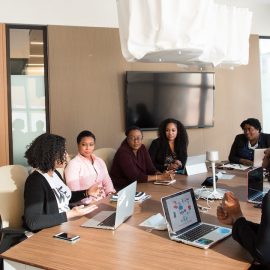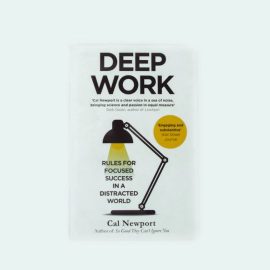
Do you know how to properly wrap up your projects and prepare for future endeavors? What steps should you take after completing a significant project to ensure continued success?
In his book Start Finishing, Charlie Gilkey outlines three vital post-project activities: tidying your workspaces, reviewing your performance, and taking time to celebrate and rest. These actions help transform completed projects into stepping stones for personal and professional growth.
Read on to discover how implementing these post-project practices can help you maintain peak performance and set yourself up for even greater success in your next endeavor.
Post-Project Steps
In his book, Gilkey stresses the importance of turning a dream into a project, as well as a realistic approach for doing so. He also provides advice for what to do after completing an authentic project. He shares three post-project recommendations:
- Tidy up your physical, mental, and digital workspaces.
- Review your performance to find ways you can do even better on your next project.
- Take care of yourself by celebrating and resting.
Clean Up After Yourself
Gilkey says that, even after your project is finished, there will be loose ends and “junk”—both physical and emotional—to tidy up. Doing this cleanup work ensures that you and your team can keep operating at peak performance in the future, rather than having to work around the remnants of old projects.
The most straightforward type of cleanup work (and often the easiest, though that depends on the type of project) is tidying up your physical workspace. This includes things like sweeping, throwing away trash, making sure your tools and equipment are clean and organized, and so on. In short, do whatever must be done to ensure that your workspace is ready for the next time you need it.
(Shortform note: In The Life Changing Magic of Tidying Up, Marie Kondo says that it’s tempting to completely clean one room at a time, but it’s actually more efficient to clean by category rather than by area. This means going through your entire workspace and gathering everything from a particular category (say, tools) into a single place, like a large table. You can then examine each individual item to decide whether you want to keep it, and if so, where to put it. Note that Kondo wrote this book to help people tidy their homes, so her specific categories—clothes, books, papers, miscellany, and mementos—may not apply to your workplace. However, the general principle of cleaning by category rather than by room still holds.)
Along with cleaning and organizing your physical workspace, the author urges you to tidy up your digital workspace in the same way. This means organizing documents into clearly labeled folders, deleting duplicates and outdated versions of files, and making sure all of your documentation and notes are easily accessible in case you need to refer back to them.
(Shortform note: Psychologists say that clutter (both physical and digital) isn’t just inefficient, it’s also harmful to your mental health. First of all, messy spaces are stressful and distracting—being surrounded by too many objects can overstimulate your brain, which tires you out and makes it hard to stay focused. Secondly, clutter makes it more difficult to find what you need, which can turn even simple tasks into frustrating ordeals. Finally, clutter often sparks feelings of shame—your home and workspace are “supposed” to be tidy, so the clutter feels like a constant reminder that you aren’t living up to that standard.)
Finally, Gilkey says that you’ll most likely also have some social cleanup to do after a project. This often involves following up on past conversations, fulfilling promises and obligations that you’ve made, and addressing any interpersonal problems that emerged during the project. This is important because any lingering resentments that team members have (toward each other or toward you) will become emotional “clutter,” hindering future work as surely as a workspace filled with physical clutter would.
(Shortform note: The Zeigarnik Effect in psychology is one explanation for the emotional clutter Gilkey describes. This is a phenomenon where people remember uncompleted or interrupted tasks more readily than completed ones, and they feel compelled to seek closure by finishing those tasks. However, the Zeigarnik Effect also applies to interpersonal relationships, causing people to ruminate on their “unfinished business” with one another—in other words, their resentments toward each other. In a work environment, that unresolved tension can be a major distraction, as well as interfering with people’s ability to work as a team. Therefore, doing social cleanup like Gilkey suggests can help you avoid such issues going forward.)
Review Your Work
Before putting away a project for good, Gilkey urges you to take time to critically examine the project as a whole and your performance during it. This process of reflecting on your work helps turn those individual experiences into personal development. That development, in turn, will help make your next project even more successful.
He models this principle on the After-Action Reviews (AARs) used in the military. The AAR process involves asking clear and specific questions about what you just went through. For example: What parts this project went well? What changes did you need to make along the way? What new skills or knowledge did you gain? What habits and practices were particularly effective?
| How to Do an AAR Contrary to what Gilkey writes here, an effective AAR is not simply a series of questions and answers. Rather, it’s an active discussion involving the entire team, centered around four specific questions: 1. What did we plan to do? 2. What did we actually do? 3. For any instances where we diverged from the plan: Why did that happen? 4. How will we achieve a better outcome next time? Alternatively, how will we repeat this success? The discussion aspect of an AAR is crucial for gaining insight and finding opportunities for improvement. Simply having your team members answer the questions individually isn’t nearly as effective because there’s no opportunity for them to challenge each other and refine their ideas. |
Celebrate and Rest
Finally, don’t overlook your needs. Gilkey says that you’re going to need to do two things after completing a difficult and stressful project: celebrate and rest.
Many people feel uncomfortable with openly celebrating their accomplishments, viewing it as boastful or unnecessary, but Gilkey argues that it’s an essential part of an authentic project. This is because a celebration isn’t just about recognizing your achievements, it’s also a chance to acknowledge the community that supported your project. Sharing your success strengthens your connections with your team and your supporters, and it can also serve as an inspiration to others. The author adds that a celebration can be as large or as small as seems appropriate: anything from sending a simple text message thanking everyone involved to throwing an actual party.
(Shortform note: Celebrating successes is one of the most effective ways to keep yourself and others motivated for future achievements. In The Molecule of More, the authors offer one explanation for why it’s such an effective practice: Making progress toward a goal causes your brain to produce a chemical called dopamine, which causes intense feelings of pleasure. Because the dopamine high is so enjoyable, it naturally motivates you to keep working toward your goals in order to recapture those good feelings.)
However, alongside the celebration, Gilkey says that transitioning between projects requires rest and reflection. This is especially true after finishing the intensely personal work involved in an authentic project. Take whatever time you need to recover from your hard work (both physically and emotionally), address any personal tasks you’ve been neglecting, and mentally prepare yourself for future endeavors.
(Shortform note: Rest isn’t just about taking time away from work—it’s also important to make sure you rest in a way that’s truly restorative. In Willpower Doesn’t Work, psychologist Benjamin Hardy says you can accomplish this by designing an environment that encourages rest and shields you from outside stressors. Some of his suggestions include decorating your resting space with art that helps you feel calm or uplifted, bringing in personal items that make you happy, and getting comfortable furniture to help you relax.)






